I have a friend named Sario who was one of the Army’s first Green Berets. He assessed into Special Forces in the 1950’s before there was a Special Forces school. Back then, senior NCOs taught the special operations trade via OJT. In 1962, Sario was part of a clandestine rescue mission into Iran. His first of three combat tours to Vietnam began in 1964.
That first trip began as TDY (Temporary Duty). That’s actually fairly quaint in retrospect considering the war went on for a decade and ultimately cost more than 58,000 American lives. Back then, however, these steely-eyes studs figured it out as they went along.
DIY Colt Model 602 Build
Sario said they first landed in Southeast Asia packing WW2-vintage small arms. They had access to anything in the inventory, but these vintage weapons were getting a bit long in the tooth. He alternated between an M2 carbine and an M3A1 Grease Gun as the mission required. Support weapons included M1919A4 belt-fed machine guns and Browning Automatic Rifles.
Advertisement — Continue Reading Below
Eventually Sario and his buddies got word of a radical new rifle. The receivers were aluminum, and the furniture was plastic. The triangular handguards and rakish carrying handle made the guns look like something out of a Buck Rogers serial. They were also lightweight, hard-hitting, and selective-fire.
These early XM16E1 rifles were the predecessors to the M16A1’s that were so ubiquitous once the war ramped up. They featured slick-sided upper receivers without a forward assist, smooth lowers, and three-prong flash suppressors. While these open-tipped flash suppressors were bad to get caught up in wait-a-minute vines, they were just the ticket for twisting the wire off of ammunition crates. Colt engineers called this particular M16 variant the Model 602.

Advertisement — Continue Reading Below
Parentage
There have been dozens of M16-variant rifles produced over the past 65 years. The earliest ArmaLite AR-15 had its charging handle located on the top of the receiver like a second trigger. The Model 601 had a slick-sided lower receiver and a removable front push pin along with a thin-profile barrel and an early duckbill flash suppressor.
The Model 602 was a very similar weapon, except that it had a slightly redesigned open flash suppressor and a retained front pushpin. Original guns also had a chrome-plated bolt carrier group. This weapon led to the Model 603, which was essentially the M16A1 used throughout most of Vietnam and well into the 1980’s.
The buttstock on the 602 was solid, where that of the 603 included a storage compartment for cleaning gear. Troops were falsely told those early rifles were maintenance-free and did not require much cleaning. Such spurious instruction contributed to the rifle’s poor performance in early combat action. The end result, however, was a critical stepping stone that eventually led to the M4 and HK416 weapons in use today.
Advertisement — Continue Reading Below
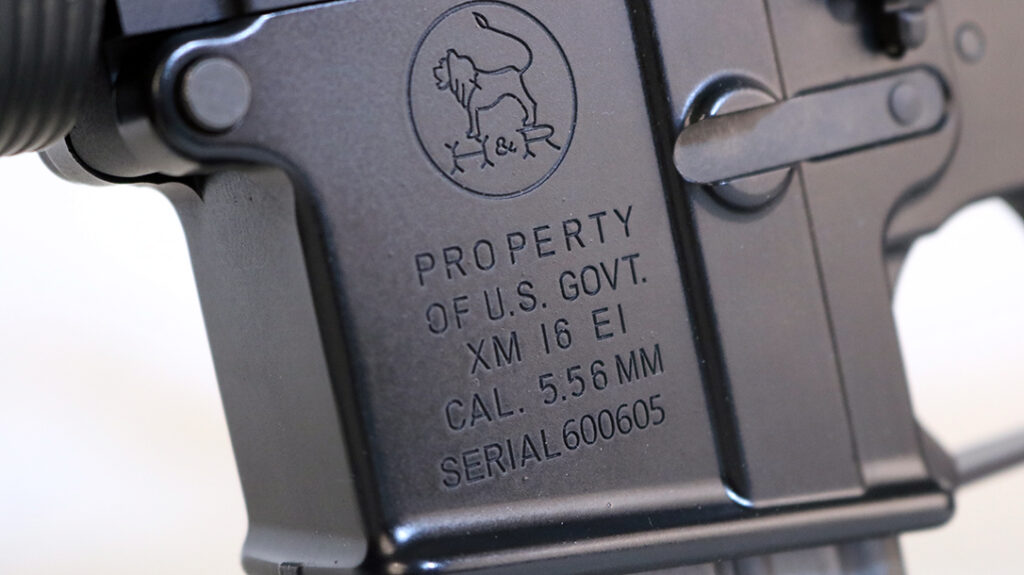
Building the Colt Model 602 at Home
There was a time where everyone wanted a stubby M4 carbine with a collapsible stock and rails aplenty. Back then you could not give those traditional full-sized M16 parts away. Nowadays we seem to be markedly more nostalgic.
Today there is a thriving industry that has arisen around building up clones of early M16 variants. There were so many variations that a guy could go broke trying to collect them all. Lord knows I have tried.
Advertisement — Continue Reading Below
This build began with a cop-surplus 20-inch 1:12-twist M16A1 barrel I landed at a small gun auction. Uncle Sam gifted local police departments thousands of GI-surplus M16A1 rifles in the aftermath of the infamous North Hollywood shootout. Many of those departments harvested the receiver sets from these guns and used them to build up stubby carbines for entry teams and use as patrol rifles. They often sold off the excess parts to help fund the conversions. That appears to be the source for my barrel and front handguards.
Luth-AR has built a thriving business around supplying quality black rifle parts. They offer a wide selection of retro gear. Their slick-sided upper receiver is period correct and anodized a deep flat black. They also offer the three-prong flash suppressor and early triangular charging handle.
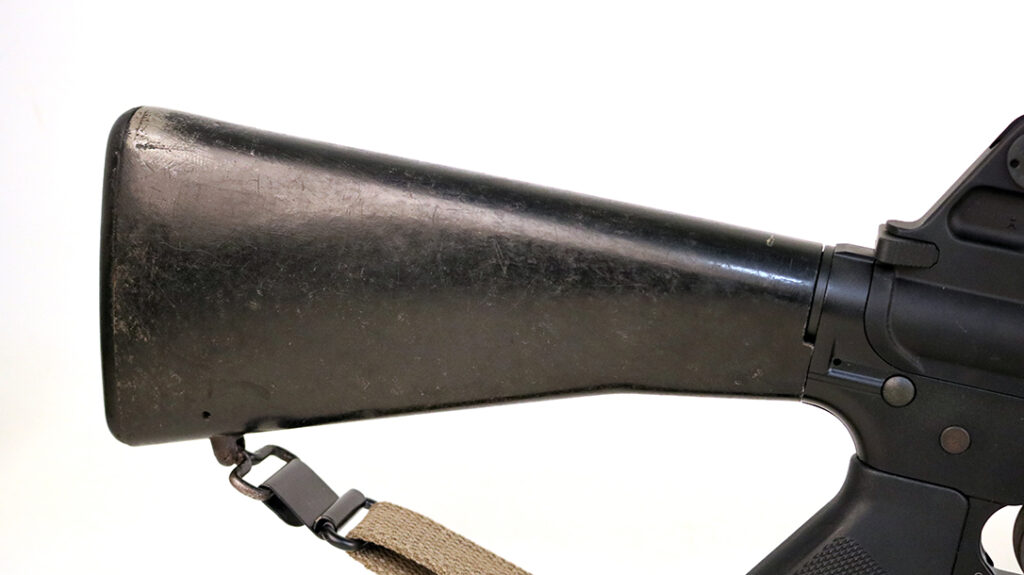
Advertisement — Continue Reading Below
Sourcing the Vintage Look
Palmetto State Armory sells superb semi-auto lower receivers bearing the Harrington and Richardson name and logo. While most H&R M16 rifles were later variants, the inclusion of their iconography adds a layer of legitimacy to the build. The nickel boron bolt carrier group also comes from PSA and is close but not quite perfect. The forward assist notches are superfluous, but it only cost me a c-note and it’s close enough.
These early model buttstocks used to be everywhere. Collectors describe them as models A through E. The Type C would be the best fit for a Model 602 build. These days those rascals are getting tough to find. Brownells once offered new-made replicas, but they were out of stock. I hunted this copy on GunBroker for a couple weeks. It is pleasantly shopworn and set me back $49.
The rubber buttplate on these old stocks is often cracked. A severely cracked buttplate will drastically reduce the stock’s value and longevity. I have found that you can drill a small hole crosswise through the crack, fill the void with decent glue, and then tap in a toothpick covered in glue to reinforce the repair before clamping it to dry and sanding everything flat. A dab of Sharpie marker on the exposed toothpick renders it all but invisible. As the toothpick is subjected solely to shear forces the repair is surprisingly strong. The entrails are standard M4 fare from Luth-AR.
Advertisement — Continue Reading Below
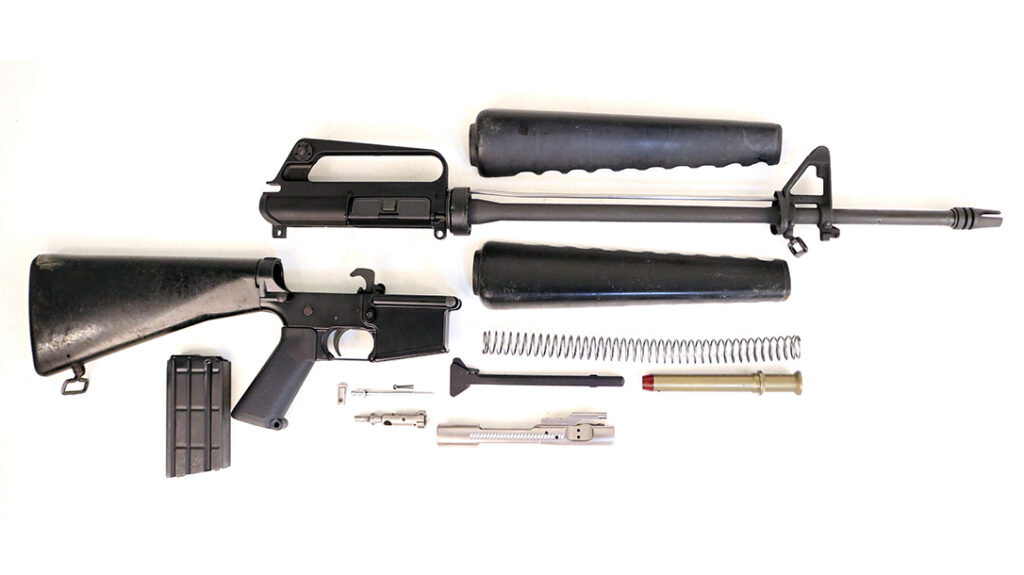
Trigger Time
It is amazing how lithe these little rifles used to be before we started hanging so much crap on them. The 1:12 barrel will not reliably stabilize heavy 5.56mm bullets (62- and 77-grain projectiles will actually tumble in flight). However, it shoots plenty straight with traditional M193 55-grain fare. The range experience is positively recreational.
At 6.3 pounds, the Model 602 weighs fully four pounds less than a sparkly new tricked-out XM7 service rifle. That makes the 602 easy to tote and fast in action. The triangular handguards are slick when wet but interface with the human form perfectly.
Advertisement — Continue Reading Below
The heavy recoil spring in the buttstock produces the most delightful twanging sound with each round fired. Even six decades after its introduction in the fetid jungles of Vietnam, this stripped down, un-accessorized Model 602 clone would render superb service as a home defense or truck gun. Recoil is a non-event, and the 602 is indeed a hoot to shoot.
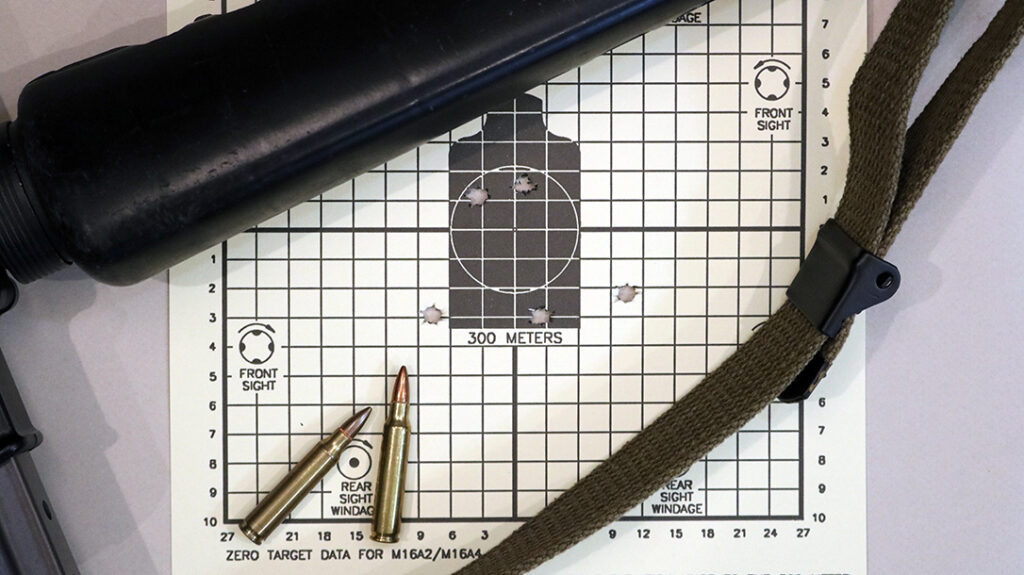
Ruminations
Sourcing the parts for your vintage Colt Model 602 build can be a bit tedious and fairly spendy. Nobody offers everything, and you are stuck paying separate shipping for each parcel delivered from a different company. You’ll also need a barrel wrench, a couple of punches, and a few basic hand tools. However, building the gun up on your dining room table is a delightfully satisfying way to kill a lazy Saturday afternoon.
Advertisement — Continue Reading Below
The practical assembly is not hard. YouTube is your buddy should you get bogged down. I recently purchased a ten-dollar set of dedicated roll pin punches on Amazon that revolutionized wrangling those small spring steel pins on the lower like the one retaining the bolt release.
The end result reliably sets you apart at the local range, nicely replicates the rifles used by those extraordinary steely-eyed warriors like Sario who deployed to Vietnam early in the war, and will ably defend your home and hearth even today. Resurrecting one from a pile of parts I hunted down myself was an exceptionally satisfying DIY project.
For parts and more info, visit Luth-AR.com and PalmettoStateArmory.com.
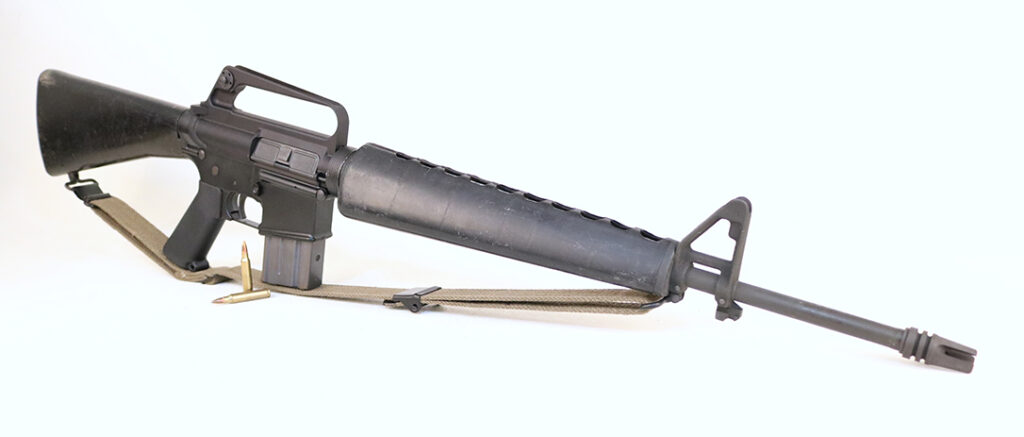
Colt Model 602 Specs
- Type: Direct Gas Impingement
- Caliber: 5.56x45mm
- Barrel: 20 incges
- Overall Length: 38.8 inches
- Weight: 6.36 pounds
- Finish: Black Anodized
- Sights: Front Post/Rear Flip Peep
- MSRP: N/A
Performance Specifications
| Load | Group Size (inches) | Velocity (fps) |
| M193 55-grain GI Ball | 2.0 | 3,013 |























